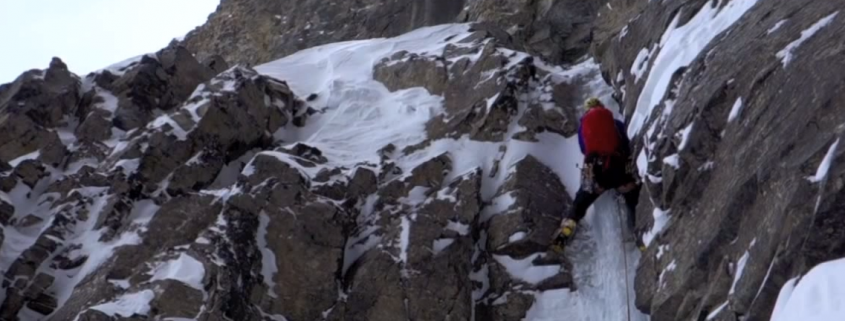IN PRACTICE – #2
By Scott Backes
Alpine Mentoring.com
“IN PRACTICE”
What separates a good day of climbing waterfalls from a bad one? In the first half of this In Practice piece, we dealt with the physical factors that influence our ascents. This second half deals with a much more nebulous and individual topic. What psychological and mental attitudes are responsible for our experiences on the ice? What can we do to influence them, and what pitfalls do we need to avoid? Obviously the answers to these questions are as varied and numerous as the individuals who climb ice. There are, however some general principals and techniques that all of us can use to put ourselves in the best possible mind-frame given our circumstances. These ideas and practices will be the focus of this In Practice piece.
When I was younger my need for recognition from my peers, and my desire to prove myself to myself often drove me to undertake ascents of ice-climbs at or above my ability. These “skin of the teeth” ascents were often begun with a samurai’s nonchalance towards the outcome. But, when grappling with the ice itself, it was mostly a different story. Often shaking with fear and failing upwards, I would flail my way to the top. These are the experiences of youth and some of you will be driven to this path. This is what is called surviving the learning curve. I cannot recommend this course, but I will put a few addendum’s on it.
When you find yourself above your head in a dire predicament stop and breathe. Slow deep breaths can do as much for calming panic as anything. If you ice tools are secure, close your eyes for a few deep breaths. Just slowing your breathing and closing your eyes will give you back some of your perspective. After your break, steel yourself to the climbing above. What I mean by this, is you must accept where you are at and accept what work must still be done. Feet are often neglected when we are afraid. Take the time to look down and find good features to stand, at the least look for solid-non-chandeliered ice to frontpoint into. When I am afraid there is a tendency to stop looking anywhere but at the ice directly in my vision. I know this about myself, so I make a conscious decision to keep looking around at my environment. So many, many times when I stop to look, there is some feature to stem to, or some mushroom I can do a back-step or drop-knee on. If your arms are so tired that you can’t control your swing, you must drop one arm at a time, resting it enough to get a good controlled swing. Each placement must be tested before you drop the next arm. It is a slow excruciating experience, but I have managed on several occasions to climb the last half of a pitch using this method. If you can find the will to stay with it, if you can accept the discomfort and pace, you can make it off the climb (at least physically) intact.
So often I have seen climbers let panic overtake their skills. I see them hurrying their placements, or pulling on tools that I wouldn’t trust in a million years. Their feeling of panic is so painful to them, so overwhelming to them that they will do anything to make it cease, they will do anything to get it over with-even if it means risking their lives. Some times they get away with it-sometimes they don’t. But, the mistake they have all made is too let panic rule them. The difference between surrendering to panic and using your fear to propel you to the top, is attitude. Before you even get out of the car, think about the breathing and use your own reservoir of experiences to consider how you have gotten yourself out of difficult situations in the past. If you believe there is a way out, there is. If your panic adds hopelessness to its burden of overwhelming fear; there is a good chance you will be lost. If you can summon hope based on past experiences, and then focus it on the situation at hand, the deep breathing and some methodical climbing will bring you back from the edge.
As I continued my arc towards ice climbing excellence, I started applying my hard-earned knowledge to each new challenge. Instead of the Samurai’s nonchalance, I adopted the attitude of the journeyman. I had a quiver of techniques and mindsets that I applied as needed. The fear of the unknown became the fear of the known, which for me is much more easily managed. My systems were ingrained to a degree, that I was able once I left the ground to forget about them. This left more time for strategy and creativity.
As you approach your objective, take the time to view the route from a distance. See the formation’s cruxes and its natural rests. Consider in your mind how much energy and mental strain will be required for each of the difficult sections and how much you think you can get back from the rests. Plot out ahead of time which aspect of the route you will climb. If you haven’t scoped the route out from a distance, once you get right underneath it, all objectivity and route choices go out the window. I can’t tell you how many times I’ve started up a route by what from underneath it looked like the wrong way, only to have my earlier scouting vindicated high up on the route. This however is not an absolute, sometimes when you are standing at the bottom; a better way-a way unseeable from a distance will present itself. Even so the work you did on the approach will still be of service. You will still know what is coming next. By keeping an open mind and by providing yourself with more options, you have spiritually strengthened your resolve and multiplied your chances for success.
Take your time at the base of the climb to secure a belay that is safe from falling ice, and one that you as the leader will have confidence in. If you have correctly positioned and set up the belay, it will be the last time you will need to concern yourself with it. You won’t be taken out of the moment by your partner shouting at you to quit knocking ice on him. You won’t have to consider when you are at the crux runout whether or not the belay will hold. Be methodical racking up and preparing your tools and yourself for the ascent. It is easy when you have adrenaline clanging around in your head to try and hurry. Usually, this results in something being dropped, something being left behind or gear being haphazardly organized. The hurried mindset carries over to the lead and it is a short step from there to panic. I am known for my speed ascents, but rarely do I hurry. I move continuously with intent and by the end of a day I have covered immense amounts of terrain. I take the time to chop away the surface ice for every screw placement, but I put each screw in at my waist to minimize the strength required to turn it and then clip it into the rope. As soon as the screw is in, I start climbing with focus and to emphasis the point again, with intent. I am always amazed at how quickly the screw is twenty or thirty feet below me, and how quickly I am at the belay.
For most of us, looking up at the first section of the climb is intimidating. The ice doesn’t look so good and the angle seems too steep for our abilities. There is a reason for this…its because its true. As I mentioned in the first piece, the first thirty to forty feet of most ice climbs is the crux. When you take that moment to compose yourself right before you start, think back to what you saw on the approach and what you’ve seen on other climbs you’ve led. The knowledge that most pillar climbs let off after the first bit can give you confidence to punch through that beginning section and get into the better ice just above. Perhaps the best compliment I was ever paid, was when one of my partners remarked to a mutual friend, “you can tell that Backes is headed for the belay”. I start up that first difficult section with fear and uncertainty in my heart, but also with a bigger measure of decisiveness and confidence that at the end of the struggle, I’ll be shouting down to my partner “off belay”
As I said earlier, there are as many strategies to cope with fear and panic, as there are climbers, but the ideas I’ve talked about here are pretty universal. The main idea with these pieces is to get you to think about your climbing from a different angle. I have found my greatest jumps in ability have come from new understandings of my self. If you are honest about what you fear and why, you can figure out methods to cope with them. In my experience, it is when I try to deny fear that it has the greatest hold on me.
Scott Backes





Leave a Reply
Want to join the discussion?Feel free to contribute!